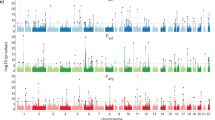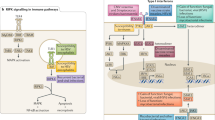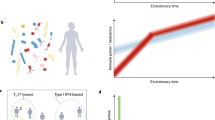Abstract
Toll-like receptors (TLRs) are key initiators of the innate immune response and promote adaptive immunity. Much has been learned about the role of TLRs in human immunity from studies linking TLR genetic variation with disease. First, monogenic disorders associated with complete deficiency in certain TLR pathways, such as MyD88-IRAK4 or TLR3-Unc93b-TRIF-TRAF3, have demonstrated the specific roles of these pathways in host defense against pyogenic bacteria and herpesviruses, respectively. Second, common polymorphisms in genes encoding several TLRs and associated genes have been associated with both infectious and autoimmune diseases. The study of genetic variation in TLRs in various populations combined with information on infection has demonstrated complex interaction between genetic variation in TLRs and environmental factors. This interaction explains the differences in the effect of TLR polymorphisms on susceptibility to infection and autoimmune disease in various populations.
This is a preview of subscription content, access via your institution
Access options
Subscribe to this journal
Receive 12 print issues and online access
$209.00 per year
only $17.42 per issue
Buy this article
- Purchase on Springer Link
- Instant access to full article PDF
Prices may be subject to local taxes which are calculated during checkout




Similar content being viewed by others
References
Janeway, C.A. Jr. The immune system evolved to discriminate infectious nonself from noninfectious self. Immunol. Today 13, 11–16 (1992).
Lemaitre, B., Nicolas, E., Michaut, L., Reichhart, J.-M. & Hoffmann, J.A. The dorsoventral regulatory gene cassette Spaetzle/Toll/Cactus controls the potent antifungal response in Drosophila adults. Cell 86, 973–983 (1996).
Takeuchi, O. & Akira, S. Pattern recognition receptors and inflammation. Cell 140, 805–820 (2010).
Gay, N.J. & Keith, F.J. Drosophila Toll and IL-1 receptor. Nature 351, 355–356 (1991).
Unterholzner, L. et al. IFI16 is an innate immune sensor for intracellular DNA. Nat. Immunol. 11, 997–1004 (2010).
Iwasaki, A. & Medzhitov, R. Regulation of adaptive immunity by the innate immune system. Science 327, 291–295 (2010).
O'Neill, L.A. & Bowie, A.G. The family of five: TIR-domain-containing adaptors in Toll-like receptor signalling. Nat. Rev. Immunol. 7, 353–364 (2007).
Lin, S.C., Lo, Y.C. & Wu, H. Helical assembly in the MyD88-IRAK4-IRAK2 complex in TLR/IL-1R signalling. Nature 465, 885–890 (2010).
Gay, N.J., Gangloff, M. & O'Neill, L.A. What the Myddosome structure tells us about the initiation of innate immunity. Trends Immunol. 32, 104–109 (2011).
Staschke, K.A. et al. IRAK4 kinase activity is required for Th17 differentiation and Th17-mediated disease. J. Immunol. 183, 568–577 (2009).
Kenny, E.F. et al. MyD88 adaptor-like is not essential for TLR2 signaling and inhibits signaling by TLR3. J. Immunol. 183, 3642–3651 (2009).
Sakaguchi, M. et al. TIRAP, an adaptor protein for TLR2/4, transduces a signal from RAGE phosphorylated upon ligand binding. PLoS ONE 6, e23132 (2011).
Carty, M. et al. The human adaptor SARM negatively regulates adaptor protein TRIF–dependent Toll-like receptor signaling. Nat. Immunol. 7, 1074–1081 (2006).
Beutler, B. Microbe sensing, positive feedback loops, and the pathogenesis of inflammatory diseases. Immunol. Rev. 227, 248–263 (2009).
Schröder, N.W. & Schumann, R.R. Single nucleotide polymorphisms of Toll-like receptors and susceptibility to infectious disease. Lancet Infect. Dis. 5, 156–164 (2005).
Arbour, N.C. et al. TLR4 mutations are associated with endotoxin hyporesponsiveness in humans. Nat. Genet. 25, 187–191 (2000).
Lorenz, E., Mira, J.P., Frees, K.L. & Schwartz, D.A. Relevance of mutations in the TLR4 receptor in patients with Gram-negative septic shock. Arch. Intern. Med. 162, 1028–1032 (2002).
Picard, C. et al. Pyogenic bacterial infections in humans with IRAK-4 deficiency. Science 299, 2076–2079 (2003).
Medvedev, A.E. et al. Distinct mutations in IRAK-4 confer hyporesponsiveness to lipopolysaccharide and interleukin-1 in a patient with recurrent bacterial infections. J. Exp. Med. 198, 521–531 (2003).
Davidson, D.J. et al. IRAK-4 mutation (Q293X): rapid detection and characterization of defective post-transcriptional TLR/IL-1R responses in human myeloid and non-myeloid cells. J. Immunol. 177, 8202–8211 (2006).
Cardenes, M. et al. Autosomal recessive interleukin-1 receptor-associated kinase 4 deficiency in fourth-degree relatives. J. Pediatr. 148, 549–551 (2006).
Chapel, H., Puel, A., von Bernuth, H., Picard, C. & Casanova, J.L. Shigella sonnei meningitis due to interleukin-1 receptor-associated kinase-4 deficiency: first association with a primary immune deficiency. Clin. Infect. Dis. 40, 1227–1231 (2005).
Comeau, J.L. et al. Staphylococcal pericarditis, and liver and paratracheal abscesses as presentations in two new cases of interleukin-1 receptor associated kinase 4 deficiency. Pediatr. Infect. Dis. J. 27, 170–174 (2008).
Ku, C.L. et al. Selective predisposition to bacterial infections in IRAK-4-deficient children: IRAK-4-dependent TLRs are otherwise redundant in protective immunity. J. Exp. Med. 204, 2407–2422 (2007).
Szabó, J. et al. Recurrent infection with genetically identical pneumococcal isolates in a patient with interleukin-1 receptor-associated kinase-4 deficiency. J. Med. Microbiol. 56, 863–865 (2007).
von Bernuth, H. et al. Pyogenic bacterial infections in humans with MyD88 deficiency. Science 321, 691–696 (2008).
Picard, C. et al. Clinical features and outcome of patients with IRAK-4 and MyD88 deficiency. Medicine (Baltimore) 89, 403–425 (2010).
Bousfiha, A. et al. Primary immunodeficiencies of protective immunity to primary infections. Clin. Immunol. 135, 204–209 (2010).
George, J. et al. Two human MYD88 variants, S34Y and R98C, interfere with MyD88-IRAK4-myddosome assembly. J. Biol. Chem. 286, 1341–1353 (2011).
Puente, X.S. et al. Whole-genome sequencing identifies recurrent mutations in chronic lymphocytic leukaemia. Nature 475, 101–105 (2011).
Ngo, V.N. et al. Oncogenically active MYD88 mutations in human lymphoma. Nature 470, 115–119 (2011).
Akira, S. & Hemmi, H. Recognition of pathogen-associated molecular patterns by TLR family. Immunol. Lett. 85, 85–95 (2003).
Zhang, S.Y. et al. TLR3 deficiency in patients with herpes simplex encephalitis. Science 317, 1522–1527 (2007).
Guo, Y. et al. Herpes simplex virus encephalitis in a patient with complete TLR3 deficiency: TLR3 is otherwise redundant in protective immunity. J. Exp. Med. 208, 2083–2098 (2011).
Pérez de Diego, R. et al. Human TRAF3 adaptor molecule deficiency leads to impaired Toll-like receptor 3 response and susceptibility to herpes simplex encephalitis. Immunity 33, 400–411 (2010).
Casrouge, A. et al. Herpes simplex virus encephalitis in human UNC-93B deficiency. Science 314, 308–312 (2006).
Sancho-Shimizu, V. et al. Herpes simplex encephalitis in children with autosomal recessive and dominant TRIF deficiency. J. Clin. Invest. 121, 4889–4902 (2011).
De Tiège, X., Rozenberg, F. & Heron, B. The spectrum of herpes simplex encephalitis in children. Eur. J. Paediatr. Neurol. 12, 72–81 (2008).
Chapgier, A. et al. A partial form of recessive STAT1 deficiency in humans. J. Clin. Invest. 119, 1502–1514 (2009).
Dupuis, S. et al. Impaired response to interferon-alpha/beta and lethal viral disease in human STAT1 deficiency. Nat. Genet. 33, 388–391 (2003).
Wlasiuk, G. & Nachman, M.W. Adaptation and constraint at Toll-like receptors in primates. Mol. Biol. Evol. 27, 2172–2186 (2010).
Radstake, T.R. et al. The Toll-like receptor 4 Asp299Gly functional variant is associated with decreased rheumatoid arthritis disease susceptibility but does not influence disease severity and/or outcome. Arthritis Rheum. 50, 999–1001 (2004).
Tao, K. et al. Genetic variations of Toll-like receptor 9 predispose to systemic lupus erythematosus in Japanese population. Ann. Rheum. Dis. 66, 905–909 (2007).
Kiechl, S. et al. Toll-like receptor 4 polymorphisms and atherogenesis. N. Engl. J. Med. 347, 185–192 (2002).
Misch, E.A. & Hawn, T.R. Toll-like receptor polymorphisms and susceptibility to human disease. Clin. Sci. (Lond.) 114, 347–360 (2008).
Brouwer, M.C. et al. Host genetic susceptibility to pneumococcal and meningococcal disease: a systematic review and meta-analysis. Lancet Infect. Dis. 9, 31–44 (2009).
Texereau, J. et al. The importance of Toll-like receptor 2 polymorphisms in severe infections. Clin. Infect. Dis. 41 (suppl. 7), S408–S415 (2005).
Casanova, J.L., Abel, L. & Quintana-Murci, L. Human TLRs and IL-1Rs in host defense: natural insights from evolutionary, epidemiological, and clinical genetics. Annu. Rev. Immunol. 29, 447–491 (2011).
Ferwerda, B. et al. Functional consequences of toll-like receptor 4 polymorphisms. Mol. Med. 14, 346–352 (2008).
Khor, C.C. et al. A Mal functional variant is associated with protection against invasive pneumococcal disease, bacteremia, malaria and tuberculosis. Nat. Genet. 39, 523–528 (2007).
Hawn, T.R. et al. A polymorphism in Toll-interleukin 1 receptor domain containing adaptor protein is associated with susceptibility to meningeal tuberculosis. J. Infect. Dis. 194, 1127–1134 (2006).
Miao, R., Li, J., Sun, Z., Xu, F. & Shen, H. Meta-analysis on the association of TIRAP S180L variant and tuberculosis susceptibility. Tuberculosis (Edinb.) 91, 268–272 (2011).
Selvaraj, P., Harishankar, M., Singh, B., Jawahar, M.S. & Banurekha, V.V. Toll-like receptor and TIRAP gene polymorphisms in pulmonary tuberculosis patients of South India. Tuberculosis (Edinb.) 90, 306–310 (2010).
Dissanayeke, S.R. et al. Polymorphic variation in TIRAP is not associated with susceptibility to childhood TB but may determine susceptibility to TBM in some ethnic groups. PLoS ONE 4, e6698 (2009).
Stein, C.M. Genetic epidemiology of tuberculosis susceptibility: impact of study design. PLoS Pathog. 7, e1001189 (2011).
Ferwerda, B. et al. Functional and genetic evidence that the Mal/TIRAP allele variant 180L has been selected by providing protection against septic shock. Proc. Natl. Acad. Sci. USA 106, 10272–10277 (2009).
Hamann, L. et al. Low frequency of the TIRAP S180L polymorphism in Africa, and its potential role in malaria, sepsis, and leprosy. BMC Med. Genet. 10, 65 (2009).
Song, Z. et al. Genetic variants in the TIRAP gene are associated with increased risk of sepsis-associated acute lung injury. BMC Med. Genet. 11, 168 (2010).
Ramasawmy, R. et al. Heterozygosity for the S180L variant of MAL/TIRAP, a gene expressing an adaptor protein in the Toll-like receptor pathway, is associated with lower risk of developing chronic Chagas cardiomyopathy. J. Infect. Dis. 199, 1838–1845 (2009).
Castiblanco, J. et al. TIRAP (MAL) S180L polymorphism is a common protective factor against developing tuberculosis and systemic lupus erythematosus. Infect. Genet. Evol. 8, 541–544 (2008).
Ladhani, S.N. et al. Association between single-nucleotide polymorphisms in Mal/TIRAP and interleukin-10 genes and susceptibility to invasive haemophilus influenzae serotype b infection in immunized children. Clin. Infect. Dis. 51, 761–767 (2010).
Durrani, O. et al. TIRAP Ser180Leu polymorphism is associated with Behçet's disease. Rheumatology 50, 1760–1765 (2011).
Valkov, E. et al. Crystal structure of Toll-like receptor adaptor MAL/TIRAP reveals the molecular basis for signal transduction and disease protection. Proc. Natl. Acad. Sci. USA 108, 14879–14884 (2011).
Nagpal, K. et al. Natural loss-of-function mutation of myeloid differentiation protein 88 disrupts its ability to form Myddosomes. J. Biol. Chem. 286, 11875–11882 (2011).
Hayashi, F. et al. The innate immune response to bacterial flagellin is mediated by Toll-like receptor 5. Nature 410, 1099–1103 (2001).
Hawn, T.R. et al. A common dominant TLR5 stop codon polymorphism abolishes flagellin signaling and is associated with susceptibility to legionnaires' disease. J. Exp. Med. 198, 1563–1572 (2003).
Hawn, T.R. et al. Toll-like receptor polymorphisms and susceptibility to urinary tract infections in adult women. PLoS ONE 4, e5990 (2009).
Hawn, T.R. et al. A stop codon polymorphism of Toll-like receptor 5 is associated with resistance to systemic lupus erythematosus. Proc. Natl. Acad. Sci. USA 102, 10593–10597 (2005).
Gewirtz, A.T. et al. Dominant-negative TLR5 polymorphism reduces adaptive immune response to flagellin and negatively associates with Crohn's disease. Am. J. Physiol. Gastrointest. Liver Physiol. 290, G1157–G1163 (2006).
Wlasiuk, G., Khan, S., Switzer, W.M. & Nachman, M.W. A history of recurrent positive selection at the toll-like receptor 5 in primates. Mol. Biol. Evol. 26, 937–949 (2009).
Dubois, P.C. et al. Multiple common variants for celiac disease influencing immune gene expression. Nat. Genet. 42, 295–302 (2010).
Sirugo, G. et al. Genetic studies of African populations: an overview on disease susceptibility and response to vaccines and therapeutics. Hum. Genet. 123, 557–598 (2008).
Kalla, A.A. & Tikly, M. Rheumatoid arthritis in the developing world. Best Pract. Res. Clin. Rheumatol. 17, 863–875 (2003).
Barreiro, L.B. et al. Evolutionary dynamics of human Toll-like receptors and their different contributions to host defense. PLoS Genet. 5, e1000562 (2009).
Ferrer-Admetlla, A. et al. Balancing selection is the main force shaping the evolution of innate immunity genes. J. Immunol. 181, 1315–1322 (2008).
The Wellcome Trust Case-Control Consortium. Genome-wide association study of 14,000 cases of seven common diseases and 3,000 shared controls. Nature 447, 661–678 (2007).
Casals, F. et al. Genetic adaptation of the antibacterial human innate immunity network. BMC Evol. Biol. 11, 202 (2011).
Fumagalli, M. et al. Parasites represent a major selective force for interleukin genes and shape the genetic predisposition to autoimmune conditions. J. Exp. Med. 206, 1395–1408 (2009).
Fornarino, S. et al. Evolution of the TIR domain-containing adaptors in humans: swinging between constraint and adaptation. Mol. Biol. Evol. 28, 3087–3097 (2011).
Ferwerda, B. et al. TLR4 polymorphisms, infectious diseases, and evolutionary pressure during migration of modern humans. Proc. Natl. Acad. Sci. USA 104, 16645–16650 (2007).
DeGiorgio, M., Jakobsson, M. & Rosenberg, N.A. Out of Africa: modern human origins special feature: explaining worldwide patterns of human genetic variation using a coalescent-based serial founder model of migration outward from Africa. Proc. Natl. Acad. Sci. USA 106, 16057–16062 (2009).
Plantinga, T.S. et al. The evolutionary history of TLR4 polymorphisms in Europe. J. Innate Immun 4, 168–175 (2012).
Fumagalli, M. et al. Signatures of environmental genetic Adaptation pinpoint pathogens as the main selective pressure through human evolution. PLoS Genet. 7, e1002355 (2011).
Stene, L.C. et al. Rotavirus infection frequency and risk of celiac disease autoimmunity in early childhood: a longitudinal study. Am. J. Gastroenterol. 101, 2333–2340 (2006).
Di Rienzo, A. Population genetics models of common diseases. Curr. Opin. Genet. Dev. 16, 630–636 (2006).
Barreiro, L.B. & Quintana-Murci, L. From evolutionary genetics to human immunology: how selection shapes host defence genes. Nat. Rev. Genet. 11, 17–30 (2010).
Abadie, V., Sollid, L.M., Barreiro, L.B. & Jabri, B. Integration of genetic and immunological insights into a model of celiac disease pathogenesis. Annu. Rev. Immunol. 29, 493–525 (2011).
Zhernakova, A. et al. Evolutionary and functional analysis of celiac risk loci reveals SH2B3 as a protective factor against bacterial infection. Am. J. Hum. Genet. 86, 970–977 (2010).
Arslan, F. et al. Myocardial ischemia/reperfusion injury is mediated by leukocytic toll-like receptor-2 and reduced by systemic administration of a novel anti-toll-like receptor-2 antibody. Circulation 121, 80–90 (2010).
Cavalli-Sforza, L.L. & Feldman, M.W. The application of molecular genetic approaches to the study of human evolution. Nat. Genet. 33 (suppl.), 266–275 (2003).
Acknowledgements
Supported by the Netherlands Organization for Scientific Research (M.G.N. and C.W.), Science Foundation Ireland (L.A.J.O.) and the European Research Council (L.A.J.O.).
Author information
Authors and Affiliations
Corresponding author
Ethics declarations
Competing interests
The authors declare no competing financial interests.
Rights and permissions
About this article
Cite this article
Netea, M., Wijmenga, C. & O'Neill, L. Genetic variation in Toll-like receptors and disease susceptibility. Nat Immunol 13, 535–542 (2012). https://doi.org/10.1038/ni.2284
Published:
Issue Date:
DOI: https://doi.org/10.1038/ni.2284
This article is cited by
-
Pathogen-specific innate immune response patterns are distinctly affected by genetic diversity
Nature Communications (2023)
-
Understanding the genetic determinant of severity in viral diseases: a case of SARS-Cov-2 infection
Egyptian Journal of Medical Human Genetics (2020)
-
E3 ubiquitin ligase RNF170 inhibits innate immune responses by targeting and degrading TLR3 in murine cells
Cellular & Molecular Immunology (2020)
-
Low adaptive and neutral genetic diversity in the endangered Antioquia wren (Thryophilus sernai)
Conservation Genetics (2020)
-
TLR9 polymorphism correlates with immune activation, CD4 decline and plasma IP10 levels in HIV patients
BMC Infectious Diseases (2019)



